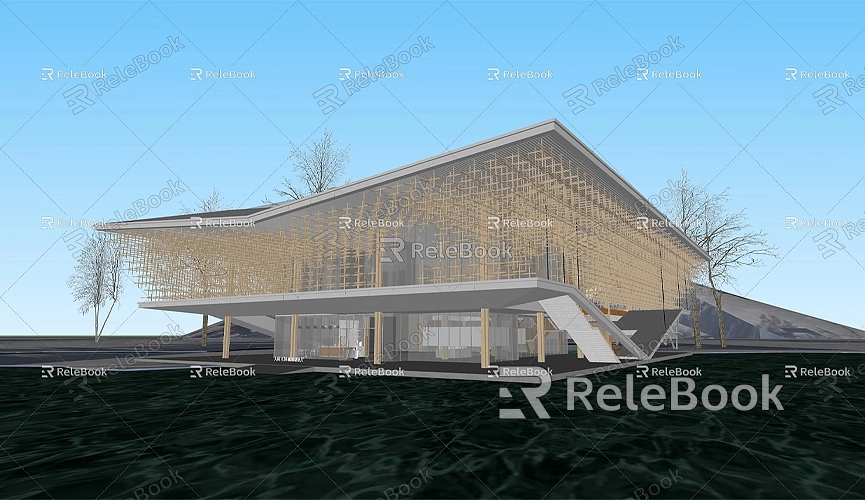How to Import a SketchUp Model into AutoCAD
In the fields of architectural design, engineering drafting, and interior design, SketchUp and AutoCAD are two widely used and important software tools. SketchUp is popular among designers for its simple, intuitive modeling approach and extensive functionality, particularly in the early stages of conceptual design and visualization. AutoCAD, as a precise drafting tool, is extensively used for detailed 2D drawings, construction plans, and engineering drafting. While these two software tools have different functions and applications, they often collaborate within the same project, especially in architectural and engineering projects, where designers and engineers need an interoperable workflow to produce accurate construction drawings.
In many cases, designers will first use SketchUp to complete 3D modeling, allowing them to better present design concepts and visualizations. Later, in order to facilitate construction and engineering design, the SketchUp 3D model needs to be imported into AutoCAD to generate detailed 2D drawings, annotations, dimensions, and detail views. The success of this import process directly impacts project timelines and quality, so learning how to efficiently and accurately import SketchUp models into AutoCAD is an essential skill for many designers.

This article will explore how to import SketchUp models into AutoCAD and provide some useful tips to help designers overcome common issues encountered during the import process and improve workflow efficiency.
Why Import a SketchUp Model into AutoCAD?
Although SketchUp excels in 3D modeling and visualization, its capabilities for detailed drafting and generating engineering drawings are relatively limited. AutoCAD, as a professional drafting software, offers more precise 2D drawing tools that are particularly suited for creating detailed construction plans, structural diagrams, and other engineering drawings. SketchUp models are typically used to showcase the exterior, interior design, and landscape effects of a building, but these designs need further refinement and modifications during the construction process.
In a complete design workflow, designers typically use SketchUp to create 3D models to help clients or teams better understand design concepts and perform initial project visualization. AutoCAD then takes over the task of converting these 3D models into construction drawings and other technical documents. Therefore, importing SketchUp models into AutoCAD ensures the continuity and execution of design concepts, ensuring a smooth transition from concept to construction.
Common Methods to Import SketchUp Models into AutoCAD
SketchUp and AutoCAD use different file formats, and AutoCAD does not directly support SketchUp’s SKP files. To import a SketchUp model into AutoCAD, we usually need to first convert the SketchUp file into a format supported by AutoCAD, such as DWG or DXF. Below are a few commonly used export methods and related considerations.
Exporting SketchUp Model as DWG Format
DWG is AutoCAD's native file format and one of the most widely used exchange formats. DWG files can store all the geometric data, dimensions, annotations, and other related information of the model. Therefore, if you want to further edit the SketchUp model in AutoCAD, DWG is the best option. DWG format supports 3D model imports and can preserve dimensions, geometry, and some other data fairly well.
When exporting a SketchUp model as a DWG file, you can choose different versions to ensure compatibility with your AutoCAD version. Typically, selecting AutoCAD 2013 or newer versions is ideal. During export, you can also choose options like exporting 3D geometry, whether to preserve material information, and whether to include the layer structure.

Here are the basic steps to export DWG format:
- After completing the model design, open SketchUp and click the "File" menu, then select "Export."
- Choose the DWG format in the export file type.
- Select the appropriate AutoCAD DWG version (AutoCAD 2013 or newer is recommended).
- Adjust export options such as whether to export textures or retain the layer structure.
- Click the "Save" button to export the file.
The DWG file exported in this manner will contain all the 3D geometric data, and once imported into AutoCAD, the designer can proceed with further detailing and modifications.
Exporting as DXF Format
DXF (Drawing Exchange Format) is a widely used CAD file exchange format that can store both 2D graphics and support the exchange of 3D data. While DXF does support 3D models, it is not as effective as DWG in preserving complex geometric structures and material data. For projects that only require importing 2D floor plans from SketchUp into AutoCAD, DXF is a lightweight and efficient choice.
The process of exporting a SketchUp model as a DXF file is similar to exporting in DWG format. You can select the "DXF" format from the "Export" options in the "File" menu. Then, based on your project requirements, adjust the export parameters and select the appropriate DXF version. After export, the DXF file will contain the geometric data from the SketchUp model and can be further edited in AutoCAD.
Using Plugins to Import SketchUp Files
If you want a more efficient way to import SketchUp files into AutoCAD, using plugins is a good option. Both AutoCAD and SketchUp have several interoperable plugins that can help you directly import SketchUp SKP files without manually converting formats. These plugins make the import process much simpler and help retain more of the model’s details.
Some plugins, like AutoCAD’s “SketchUp Import Plugin,” can directly read SketchUp files and convert them into formats that AutoCAD understands. These plugins not only automate the file conversion but also preserve more detail during the import process, reducing the need for manual adjustments.
While these plugins offer a more straightforward import method, it’s still important to ensure that the plugin version is compatible with both the AutoCAD and SketchUp versions being used, as incompatibilities may cause import failures or loss of model details.
Common Issues and Solutions During Import
When importing SketchUp models into AutoCAD, designers often encounter some issues. Understanding these problems and taking effective measures to resolve them can help ensure a smooth import process.
Scale Inaccuracies
Scale issues are one of the most common challenges during import. Since SketchUp and AutoCAD use different unit settings, the model may appear incorrectly scaled when imported. To resolve this, designers should set the correct units in SketchUp and ensure the proper scale during export. You can check and modify unit settings in SketchUp via the “Model Info” panel to ensure they match the units used in AutoCAD. Additionally, be sure to verify the unit settings in AutoCAD during the import process to avoid scale issues.
Missing Textures and Materials
Textures and materials in SketchUp are often lost when importing into AutoCAD. Since AutoCAD is primarily used for 2D drafting and has limited support for 3D models, especially for complex materials and textures, these elements may not carry over. To avoid this issue, it's recommended to avoid overly complex materials in SketchUp, and if textures need to be reapplied in AutoCAD, they can be manually adjusted.
File Format Incompatibility
File format incompatibility can arise during the import process, especially when using different versions of SketchUp or AutoCAD. This may result in the file failing to import properly. To solve this, designers should ensure they are using the latest DWG or DXF versions supported by AutoCAD. Additionally, ensure that the SketchUp export version is compatible with AutoCAD to avoid format issues.
Loss of Detail After Import
When importing SketchUp models into AutoCAD, especially when exporting complex 3D models, some details, such as layer structure, annotations, and complex geometry, may be lost. To prevent this, designers should try to simplify unnecessary parts of the model and select options to preserve layer structure and geometric data during export.
Tips for Improving Import Quality
To ensure that SketchUp models retain as much detail and accuracy as possible when imported into AutoCAD, designers can follow these optimization tips during the export and import process:
- Optimize the Model: Simplify unnecessary polygons and details to reduce the chances of problems during the import process.
- Use High-Quality Textures and Materials: While AutoCAD’s support for textures is limited, using high-resolution, simple materials can help ensure the best possible import results.
- Check Unit and Scale Settings: Verify unit settings in both SketchUp and AutoCAD to ensure consistency, thus avoiding scaling issues.
- Use Plugins for Import: Using AutoCAD and SketchUp-compatible plugins can improve import accuracy and reduce manual adjustments.
By following these tips and utilizing the appropriate export methods, designers can efficiently and accurately import SketchUp models into AutoCAD, ensuring a smoother workflow and better collaboration between 3D modeling and technical drafting tasks.

